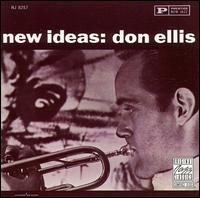New Ideas
Date(s) Recorded
May 11, 1961
Tracks
1. Natural H. (Ellis) – 4:33
2. Despair to Hope (Ellis) – 4:19
3. Uh-Huh (Ellis) – 8:15
4. Four and Three (Ellis) – 5:05
5. Imitation (Ellis) – 7:57
6. Solo (Ellis) – 2:17
7. Cock and Bull (Ellis) – 7:06
8. Tragedy (Ellis) – 5:12
Credits
Jaki Byard – Piano, Alto Sax
Ron Carter – Bass
Don Ellis – Trumpet
Al Francis – Vibraphone
Charlie Persip – Drums
Liner Notes
Don Ellis
Releases
Prestige (1961)
New Jazz OJCCD-431-2 (1992) – CD Reissue: Available at CDNOW for $10.49
“Despair to Hope” from New Ideas featuresimprovisation based on an emotional framework, rather than a musical one. Ellis provided a detailed explanation of his approach in the album’s liner notes:
“The inspiration for ‘Despair to Hope’ came while listening to a John Cage concert. The concert tended to make one more aware of the music in the sounds surrounding us in our daily living, but I had
the feeling that jazz musicians, given the conception, could do much more with the indeterminacy principle involved.
One of the pieces, ‘Cartridge Music,’ was performed by Mr. Cage and David Tudor. They had cards to which they referred, presumably for directions. This
to me, is ‘controlled’ indeterminacy, which is an extension of something which has been taking place in music for a long time. It seemed valid to take Cage’s idea one step further and not predetermine anything except the performers and their instruments. The idea of having planned cards with predetermined choices seemed too rigid. If the performers had more freedom they would be able to interact with the audience even more – giving a heightened dimension. Classical musicians, I reasoned, are not trained for this type of extemporizing today, but jazz musicians are. Why not see what could be done? A great deal in jazz has always been left up to chance, but a framework of some sort was always in use (whether written, or stylized by custom).
Al Francis and I tried improvising a duet with just free associations. This was not satisfying to me. I needed to hear more of an overall direction than aimless rambling. The idea of using
an emotional framework, rather than a musical one occurred to me. We tried it once keeping in mind the thought of progressing from despair to hope. It ‘happened.’ I did not try it again before the record date for fear of establishing any set musical routine. When we came
into the studio, this was the first thing recorded. Other than the emotional framework and the instruments and means at our disposal nothing was planned. We did one take.”


